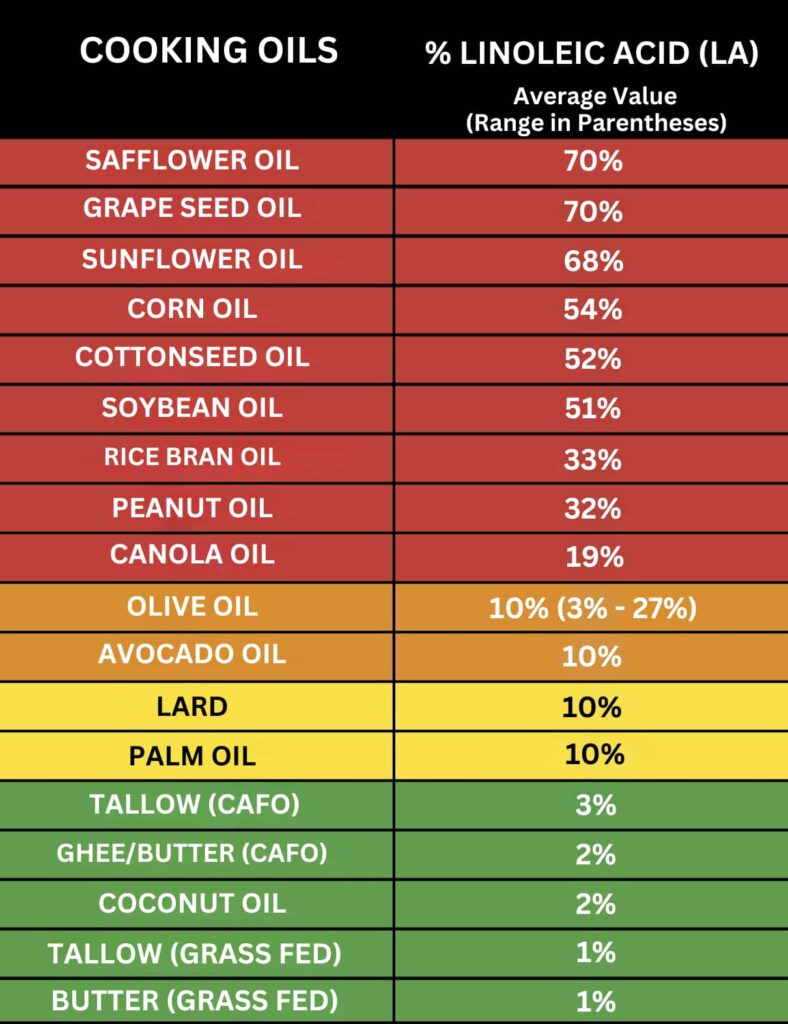On supermarket shelves and in advertisements, seed oils such as canola, soybean, sunflower, corn, and others (also known as vegetable oils) are promoted as “healthy” and “natural” options. However, these claims are far from the truth.
In this article, we aim to debunk the myth surrounding seed oils, expose the risks they pose to human health, and explain why these products are anything but natural.
The Extraction Process: A Chain of Industrial Chemistry
Unlike natural oils like coconut or extra virgin olive oil, which are obtained through simple methods such as mechanical pressing, seed oils require highly complex industrial processes.
How Are Seed Oils Extracted?

This diagram illustrates that the production process involves multiple stages where seeds are subjected to extremely high temperatures, reaching up to 500°F, and chemical solvents are used to extract the oil.
For instance, during the initial extraction stage, temperatures typically range between 140°F and 302°F, but in the final deodorization phase, they can climb as high as 500°F, this extreme heat causes oxidation even before the product reaches our kitchens, and this oxidation accelerates further when the oils are exposed to heat, light or air during storage or cooking.
Subsequently, the oils are deodorized and bleached to mask their original odor and color, resulting in an ultra-processed product that has little to do with being natural.
A Modern Phenomenon with Catastrophic Consequences
The Origins of Seed Oils
The widespread consumption of seed oils is a relatively recent phenomenon, at the beginning of the 20th century, the intake of these oils was virtually nonexistent, this is because seed oils cannot be obtained naturally like traditional oils; instead, they require a highly complex industrial process that didn’t exist in those earlier times.
In fact, the heating during the final deodorization stage causes the oils to oxidize and become rancid, rendering them unsuitable for human consumption. However, this final step eliminates the unpleasant odors they acquire during production, without this process, the smell of these oils would be so pungent and unbearable that no one would consume them, they would ruin any dish with their foul odor.
From Industrial Use to Food: The Case of Crisco
A notable example in the history of seed oils is cottonseed oil, which was initially used primarily to manufacture candles and soaps. It was also occasionally used as a lubricant in certain machinery, though evidence suggests this application was not as common.
At that time, whale oil was the primary source of fat used in industry. However, the overexploitation of whales led to the search for alternatives, and cottonseed oil stepped in as a substitute for industrial purposes.
The turning point came in June 1911, when Procter & Gamble revolutionized the market by introducing Crisco (1), the first solid “cottonseed” fat marketed as a food product and presented as an alternative to lard, crisco marked the first time in history that a processed vegetable oil was mass promoted as suitable for human consumption. This event sparked the displacement of traditional fats like butter, lard and beef tallow, which had been essential fat sources for centuries.
Yet, the promotion of seed oils as “healthy” was heavily influenced by marketing campaigns and biased studies in the 20th century, leading to a dramatic increase in their consumption. For example, soybean oil consumption surged by 1,163 times between 1909 and 1999 (2).
It’s worth noting that although soybean oil existed as early as 1909, its use was minimal and limited to industrial purposes. It wasn’t until after 1911, with the success of Crisco and advancements in vegetable oil refining, that soybean oil began to be processed and widely used in human diets.
The Rise of Seed Oils and Its Impact
Over time, more seed oils, such as corn and sunflower oils, were introduced to the food market, promoted as “healthier” options. However, their production process and health effects have sparked debate. Studies have found that their oxidation and high omega-6 fatty acid content contribute to inflammatory and metabolic issues in the body (3). Moreover, in the modern Western diet, many foods are fried in these oils, while omega 3 intake remains insufficient to counterbalance their effects.
What’s more, seed oils are chemically unstable due to their high content of polyunsaturated fats, such as linoleic acid, making them more prone to oxidation compared to saturated fats (like coconut oil or butter) or monounsaturated fats (like olive oil), this chemical instability is a primary reason they produce toxic compounds, such as aldehydes, when heated beyond their smoke point, a common occurrence during frying or high-temperature cooking.
The Cholesterol Hypothesis and Its Legacy
In the 1950s and 1960s, the cholesterol hypothesis (which linked saturated fats to heart disease) caused traditional fats like butter and lard to be demonized, while vegetable oils were promoted as a “healthier” alternative. However, recent research has challenged this hypothesis, showing that saturated fats are not as harmful as previously thought.
A Coincidental Rise in Chronic Diseases?
The rise of seed oils not only transformed the food industry in the 20th century but also changed how humans consume fats, replacing traditional, natural sources with highly industrialized products. As a result, their consumption has skyrocketed, coinciding with an alarming increase in chronic diseases among adults: from 7.5% in the 1930s to approximately 60% in 2020 (4)(5)(6), coincidence?
As of this year, no official figures have been published, but we can make a reasonable estimate based on trends. A 2023 study published in Frontiers projects that by 2050, the number of adults over 50 with at least one chronic disease will increase by 99.5%, rising from 71.522 million in 2020 to 142.66 million in the U.S. alone (7). Considering that 60% of adults already had at least one chronic disease in 2020, and with an aging population (projected to grow by 61.11% among those over 50 by 2050), it’s likely that the percentage of adults with chronic diseases in 2025 is slightly above 60%, possibly between 62% and 65%.
While we believe this increase is linked to seed oil consumption based on the available evidence, it’s important to note that the rise in ultra-processed food consumption (which often contains these oils, even in baby formula “milk”) and sedentary lifestyles have also contributed to this trend.
The Dangers of Seed Oils for Your Health
Omega-6 and Chronic Inflammation
Seed oils are rich in omega-6 fatty acids, particularly linoleic acid, a precursor to pro-inflammatory eicosanoids, when consumed in excess without a proper balance of omega-3, these fatty acids promote chronic inflammation in the body (8).
To put this into perspective, the ancestral diet had an omega-6 to omega-3 ratio close to 1:1, but today, that ratio is approximately 20:1. A ratio of 4:1 has been associated with a 70% reduction in cardiovascular mortality (9)(10). This significant imbalance directly affects cells and tissues, exacerbating conditions like arthritis, cardiovascular diseases, and even mental health issues such as Alzheimer’s, anxiety, and depression, as well as autoimmune diseases and metabolic disorders (11)(12).
Did You Know Seed Oils Can Also Disrupt Your Gut Microbiota?
Additionally, these omega-6-laden oils create an inflammatory environment that disrupts the beneficial bacteria in your gut. Studies have shown that this imbalance can contribute to issues like obesity, type 2 diabetes and even inflammatory bowel diseases (13).
Linoleic Acid and Its Impact on the Body

As you can see in this table, oils with the highest content of LA, such as safflower (70%) and sunflower (68%), are the most problematic and unfortunately, the most commonly used in processed foods and frying, further worsening the omega-6/omega-3 imbalance, in contrast, oils like coconut or butter have much lower levels, making them safer options.
Olive oil, with a range of 3% to 27%, is a middle ground option, but its chemical stability (thanks to its high monounsaturated fat content and antioxidants like polyphenols) makes it far healthier than seed oils, provided you choose a high quality option, such as cold-pressed extra virgin olive oil.
On the other hand, the high linoleic acid content also contributes to oxidative stress, mitochondrial dysfunction and genetic damage, which are key factors in the development of cancer and other chronic diseases that fill hospitals (14).
Mortality and Heart Disease
The risks don’t stop there, a seven year study revealed that groups with high consumption of vegetable oils had a 62% higher all-cause mortality rate compared to those who consumed less (15). In this study, researchers divided participants into two groups: both consumed the same amount of fats and oils in their daily meals, but the source of those fats differed, one group primarily used vegetable oils, such as safflower oil and margarine, while the other used olive oil and real butter, apart from this, their dietary habits and lifestyles remained unchanged.
After seven years of monitoring, researchers found that those who consumed more vegetable oils had a significantly higher mortality rate (62% higher). Similarly, the well-known Minnesota Coronary Experiment, conducted between 1968 and 1973 with over 9,000 participants, found that individuals who increased their intake of corn oil and margarine had an 86% higher incidence of heart attacks, despite having lower cholesterol levels, these findings were reaffirmed in a 2016 reanalysis (16).
The Dangers of Frying with Seed Oils
Furthermore, seed oils like canola or sunflower have a low smoke point, meaning they release toxic compounds, such as aldehydes, when used for frying or cooking at high temperatures. A recent study found that when frying at high temperatures, these oils produce aldehydes—harmful molecules that accumulate in foods like French fries, reaching up to 25 ppm, a concerning level (17).
Likewise, another study discovered that oils become toxic when heated excessively or reused multiple times. Within just minutes of frying, harmful substances like aldehydes begin to form, accumulating even more with continued use of the same oil (18), the solution? Opt for more stable options with a higher smoke point and store them away from sunlight.
These findings invite us to reflect: what we’ve been sold as “healthy” might be doing more harm than we think.
Healthier Alternatives for Your Kitchen
So, if seed oils are so harmful, what are the healthier options? Fortunately, there are natural fats that don’t require complex industrial processes and that the human body can metabolize effectively. Plus, these options are more stable for cooking.
Oils like unrefined avocado oil have higher smoke points and are much safer, other options include:
- Virgin olive oil: better for cooking due to its higher smoke point compared to extra virgin, though both are great for different uses (we’ll cover this in a future post).
- Clarified butter (ghee)
- Beef tallow
- Lard
For example, olive oil and coconut oil contain natural antioxidants, such as polyphenols or medium-chain fatty acids, which protect them from oxidation and provide health benefits, from improving brain function to supporting cardiovascular health (19)(20).
These fats have been unfairly demonized, but recent studies are revealing that they are not only safe but also beneficial, consider this: the beef tallow or lard our grandmothers used is pure, stable and perfect for frying or cooking, without the risks of processed vegetable oils.
Take the First Step Toward a Healthier Life
To start, a good tip is to read the labels of processed products: look for terms like “vegetable oil”, “soybean oil” or “canola oil” in the ingredient list and opt for products that use healthier oils instead.
The next time you cook, rethink the type of oil you use, switching your oil choices and steering clear of ultra-processed foods can make the difference between robust health and future chronic issues.
In future posts, we’ll dive deeper into the specific benefits of each of these natural fats, we’ll also explore how you can incorporate more omega-3 into your diet to counterbalance excess omega-6 and restore harmony in your body.
For now, remember that the first step toward a healthier life begins with questioning what we’ve been led to believe about seed oils, small changes, like choosing a more natural oil, can have a tremendous impact on your long term well-being. Today is the day to start taking control of your health!

